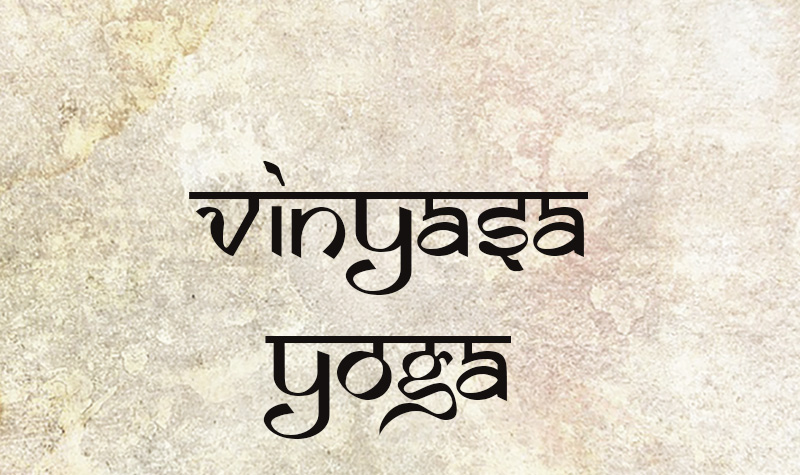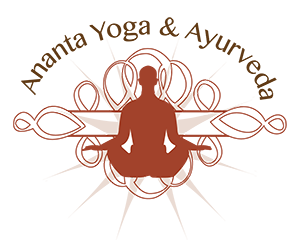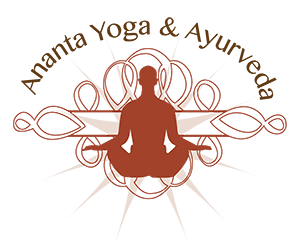
Vinyasa Yoga
Vinyasa Yoga is a form or a method of teaching Classical Yoga. It is the step by step study, practice and attainment of Yoga (unification) of Mind, Body and Breath into one harmonious experience.
To explain the teaching approach of Vinyasa Yoga it is important to understand the practices of Yoga presented in Patanjalis Yoga Sutras and The Hatha Yoga Pradipika – amongst other important texts – which it embodies and teaches.
Yoga – In its entirety, is the study, practice and application of the Eight – Limbed Path (Ashta – Anga) of Yoga gifted to us by Patanjali in his Yoga Sutras. The map of the eight limbed path deals with all of the elements of fundamental human suffering due to physical and mental ailments and unhelpful external influences from the world and societies we live in. By following this eight limbed path or map – little by little the suffering of human existence dissolves and a state of peace prevails. The system of Hatha Yoga is a three part process (maha yoga) whereby a set of tools as described in The Hatha Yoga Pradipika – (asana, kriya, pranayama, mudra, yantra, mantra and laya ) are used correctly and appropriately in the implementation of the steps of Patanjalis eight-fold path. If practiced diligently this path leads towards the unification of the two opposing solar and lunar energies of sun (ha) and moon (tha) – hatha – which is the state of samadhi or Raja Yoga (royal union) and mental clarity and peace.
Yoga is a system that can be used to achieve enlightenment or self-realisation. Although this is the ultimate goal of yoga it can not become a fixed state of attachment. Yoga is an ever evolving process of small realisations and enlightenments as we learn from and make our way through the lessons of life. By becoming attached to the concept of enlightenment/eternal bliss as being something other than our natural state – we set ourselves up for disappointment, suffering and restlessness while missing out on the lessons the entire process is there to teach us. The idea of getting somewhere or attaining something creates yet another duality or separation in which we become bound. While the sincere practitioner keeps his/her mind firmly fixed on the end goal which is to realise the nature of ones true self – It is the journey and the process – not the destination which holds the key to liberation (moksha) from suffering. Through the teachings of Yoga & Samkhya philosophies, we discover firstly who we are not before realising the true nature of the Self which is the all pervading non-dualistic consciousness hidden by the veil of Maya (illusion).
Regular yoga practitioners treat their body with great respect as it is considered to be the vehicle of the soul and its potential awakening. Yoga students receive numerous physical & mental benefits. These include – increased strength, flexibility & stamina, increased energy and vitality, improved general health, a greater awareness and discernment of limiting & habitual thought patterns and attitudes to nutrition & lifestyle habits (samskaras), enhanced mood , concentration, mental clarity and an overall sense of calm and well-being.
The practice of Yoga in the early stages of a yoga practitioners journey – which can take many years – cultivates the first five of the eight-fold path of Patanjaili’s Yoga system to purify, open and strengthen the body and mind in preparation for the journey and process of yoga. The first five limbs of the eight-fold path (see below) of Yama, Niyama, Asana, Pranayama & Pratyahara are known as Bahiranga Sadhana (External Practices). These first five steps are the only logical place to begin as they deal with what is”external”, “outer” or “outside” and therefore tangible and accessible to all of us. These five limbs can be experienced and explored by everyone with the correct guidance. These practices which work on cleaning up the physical body and deal with distractions from the outside world are known as Hatha Yoga.
The practice of Bahiranga Sadhana (External Practices) which constitute Hatha Yoga – prepare the practitioner on a physical and energetic level and – eventually leads to the remaining three limbs of Antaranga Sadhana (Internal Practices) .
The remaining three limbs of the eight-fold path (see below) of Dharana, Dhyana & Samadhi are known as the Antaranga Sadhana (internal practices) and are known as Raja Yoga or Royal Union. They are described as such because they cannot be observed from the outside, but instead are undertaken within and beyond the mind. They are a set of practices which encourage progress on a yogi’s spiritual path. They are considered internal aids to Self-realisation. However – these practices can elude many practitioners in the early stages of their yoga journey because of the constant distraction of discomfort, stiffness and blockages in the external physical body and their associated mental distractions. Therefore Bahiranga (External Practices) need to be well established and reasonably effective before approaching the Antaranga Sadhana (Internal Practices) – despite the yogis desire, intention and best efforts to practice both. (See Note (c) below).
Bahiranga Sadhana – described below – is understood by most to begin with the Yamas and end with Pratyahara. The five limbs of the Bahiranga Sadhana are –
- The five Yamas – the personal virtues/restraints of ahimsa (non-violence), satya (truthfulness, asteya (not stealing), brahmacharya (self-discipline and self-denial) and aparigraha (non-possessiveness).
- The five Niyamas – the codes of behaviour/observances of shaucha (purity of mind and body), santosha (contentment), tapas (self discipline), svadhyaya (self-study) and ishvara pranidhana (devotion to a higher source). (see note (a) below)
- Asanas – postures which are used to strengthen and discipline the body through their underlying therapeutic benefits. When practiced diligently with deep awareness and correct use of the breath, Asana works to free both the mind and body of restrictions, limitations and blockages on a physical and energetic level by activating the 108 Marma (vital junctions) and freeing up Prana (lifeforce) so it can move freely through the 72,000 Nadis (energy channels).
- Pranayama -(mastery of the vayus/pranic lifeforce winds through breath cultivation) – rejuvenates the body and mind by sending the Prana or life force energy in the correct way where it is needed.
- Pratayahara – is the transcending or withdrawal of the senses. In this practice, the yogi observes the eternal world objectively to enhance his/her inner growth. It is the transition between the external (Bahiranga) and internal (Antaranga) practices. (see note (b) below)
Antaranga Sadhana – described below – is understood by most to begin with Dharana and end with Samadhi. The three limbs of the Antaranga Sadhana are –
- Dharana – develops and increases the yogis ability to concentrate. It can be cultivated by focusing on a particular aspect of the physical practice while moving or on a particular object such as a candle flame while seated. Dharana leads to –
- Dhyana – is a state of mind in which the yogi is in deep meditation. He/she is aware of a stream of thought which flows steadily around the object of the meditation. To be in dhyana is to be completely free from distraction.
- Samadhi – is the experience of total unity with the yogi’s true/inner self. In a state of samadhi, the yogi experiences no separation between the individual consciousness and universal consciousness. They are no longer separate but united as one. There remains no conflict, no thought and no disturbance in the mind. Samadhi is a state of absolute bliss. It is the ultimate goal of all yoga endeavours.
Notes –
(a) Although most yoga practitioners will be practicing the Yamas (restraints) and Niyamas (observances) as best they can in their daily lives – complete adherence to and embodiment of these limbs is further manifested and implemented through the practice of Asana and Pranayama together with Mitahara Agni (controlled intake of pure food).
(b) Some yogis consider the fifth limb – Pratayahara – to be part of the external practices (Bahiranga Sadhana) and some consider it to be part of the internal practices (Antaranga Sadhana). Some consider it to be the bridge between the two leading us through the withdrawal of the senses from external distraction to internal stillness.
(c) In Patanjali’s Yoga Sutras, he encourages yogis to go beyond their external practices of the first five limbs of yoga (Bahiranga Sadhana) and develop their Antaranga Sadhana) whih works to transform the mind itself. It is said that these practices will change the chitta or fluctuations of the mind permanently. They also strengthen the positive habits of the mind by excluding distractions.
Vinyasa Yoga – As an approach to Yoga – Teaching Methodology & Lineage
The majority of yoga classes taught in our studios follow this method of teaching which is firmly rooted in the teaching lineage of Professor Tirumalai Krishnamacharya who is known worldwide as the father of modern yoga. He revolutionised Yoga in the 20th Century and made it accessible to everyone. His students, including Indra Devi, Pattabhi Jois, BKS Iyengar, Srivatsa Ramaswami and Krishnamacharya’s sons TKV Desikachar & T.K. Sribhashyam testify to his life’s work and to the breadth of teachings that he stood for. They underline his position as one of the most significant Yoga masters, teachers and therapists of the modern era.
The Vinyasa teaching methodology draws from aspects of all the teachings of the main students (mentioned above) of Krishnamacharya – from the attention to alignment of Iyengar Yoga, the rhythm and flow of Ashtanga Yoga, the intelligent sequencing of Vinyasa Krama and the therapeutic approach and application of yoga as a therapy of Vini Yoga. The common thread between all of these approaches to teaching classical yoga is the attention to the breath. We believe firmly through our experience as dedicated students of yoga – as well as teachers – that this teaching approach is a well rounded and beneficial one to all of the students who attend our classes.
The word Vinyasa when broken down means variation (vi) within the specified (ni) parameters (aasa). More simply put Vinyasa can mean “breath connected movement” or “placement” and the Sanskrit word Yoga means to “yoke” or “unite” – it also means “mental peace” depending on which root word of yoga one interprets its meaning from.
Vinyasa Yoga classes focus on linking Yoga Asana (postures), Pranayama (mastery of the vayus/pranic lifeforce winds through breath cultivation) and Pratayahara (withdrawal of the senses), three of the eight limbs of classical Yoga and part of the Bahiranga Sadhana to bring the mind and body into unity which eventually prepares the practitioner for the internal meditative practices of the Antaranga Sadhana.
The progressive approach used in teaching Yoga through the Vinyasa system makes these classes accessible to all ages, abilities and levels of fitness and is known as Vinyasa Krama (intelligent sequencing). Both male and female students of all ages benefit hugely from this form of yoga – each discovering their strengths and weaknesses in different forms.
The system recognizes that every student faces their own individual challenges and that no two bodies are the same. The practice of Vinyasa Yoga can be adapted and changed to suit each stage of life as we are all in a constant state of change and therefore so too are our needs. Every student is encouraged to work at their own pace in a well structured, safe and non-competitive class environment.
Guided classes begin with preparing, aligning and opening the body sensitively in the three platforms or stabilising junctions of the body ie -the feet and ankles, hips and pelvis, neck and shoulder girdle, gently heating the body from the inside through targeted & general warm ups. Using fundamental building blocks and structured teaching methodology so each student can explore the postures from their foundations, the class progresses into an intelligently sequenced flow of classical Yoga Postures which are linked to each other on the thread of the breath which is a slow, deliberate breath known as Uujayi.
The sequence practiced and the pace of the class will be determined by the ability and experience of students in the group and will include all or some of the following – depending on the level and theme of the class:
- Standing Postures,
- Sun Salutations,
- Standing Forward Bends and twists,
- Balancing Poses,
- Inversions,
- Backbends,
- Seated Forward Bends and Twists.
Modifications and variations of each pose are explored when necessary to suit the needs of each individual student so that the body remains safe and the underlying benefits of each posture and every aspect of the practice is made accessible to everybody, regardless of age, gender or fitness levels.
The beauty of Vinyasa Yoga is that although the basic structure of the class is consistent – no two classes will ever be completely the same and so the mind does not become attached to a particular sequence or way of doing things which can often lead to complacency and injury. It offers the practitioner the opportunity to embark on their own personal Svadhyaha (self-study) on a physical, psychological, emotional and spiritual level so their practice becomes a meditation in movement.
The ultimate goal of Vinyasa as with all styles of yoga is to create a heightened sense of personal awareness on every level and to unite the body, mind and breath into one harmonious experience using ancient Hatha Yoga techniques – as described above.
We hope that your experience in our classes will – at the very least – help you on your journey of self-discovery and offer you the opportunity to de-stress, unwind and to find a greater sense of calm and stillness which is our natural state. We hope that you will leave at the end feeling rested yet energised, calm, open and light with a deeper sense of connection to yourself and integration with the world around you.
Please firstly follow the links below to read about the various class levels on offer so you can make an informed decision about which class is most suitable for you at this time.
Beneath the class descriptions you can then follow the link to the full schedule of weekly classes/courses to help you find a class at a suitable time.
You can also follow direct links below to the Teacher Profiles of our instructors.
If you cant find the class you are looking for on the schedule at present please contact Liz Richards on 086 8963425 to find out when the next block begins.
All Vinyasa Yoga Classes are open to both male and female students from 16 years of age. Separate teen classes cater for those aged 12 – 15.
These are gently paced, well planned courses of generally 6, 8 or 10 consecutive classes which starts at the very beginning. Students learn how to align, open and strengthen the body gradually while stabilizing the platforms of the feet and ankles, hips and pelvis and shoulder girdle.
A gently paced class in which the focus is very much on building a safe and strong practice using the Hatha Yoga principles of alignment and correct use of the breath.
This class moves at a more flowing pace and slightly more advanced postures and vinyasas (sequences linking one pose to the next) are introduced through the Vinyasa Krama teaching methodology.
This class moves at a more flowing pace and slightly more advanced postures and vinyasas (sequences linking one pose to the next) are introduced through the Vinyasa Krama teaching methodology.
Vinyasa Yoga classes are taught by –
Liz Richards – 086 8963425
View Full Teacher Profile here >>
Louise Curran – 087 6032202
View Full Teacher Profile here >>
Maxine Bonus – (086) 8052486
View Full Teacher Profile here >>
Mark Kinghan – (087 2217783
View Full Teacher Profile here >>


